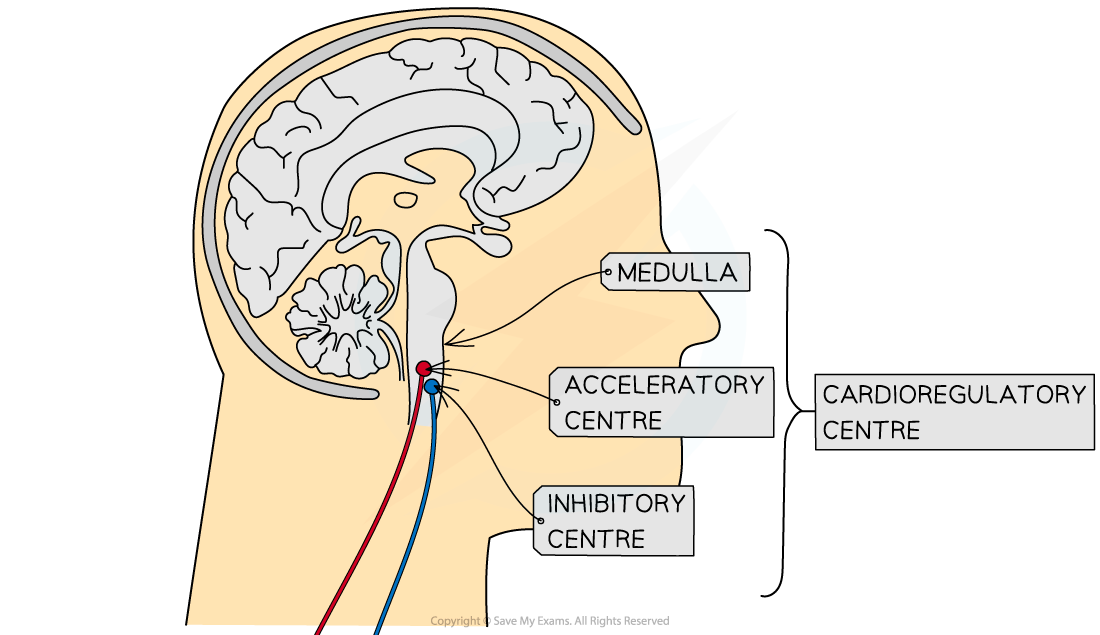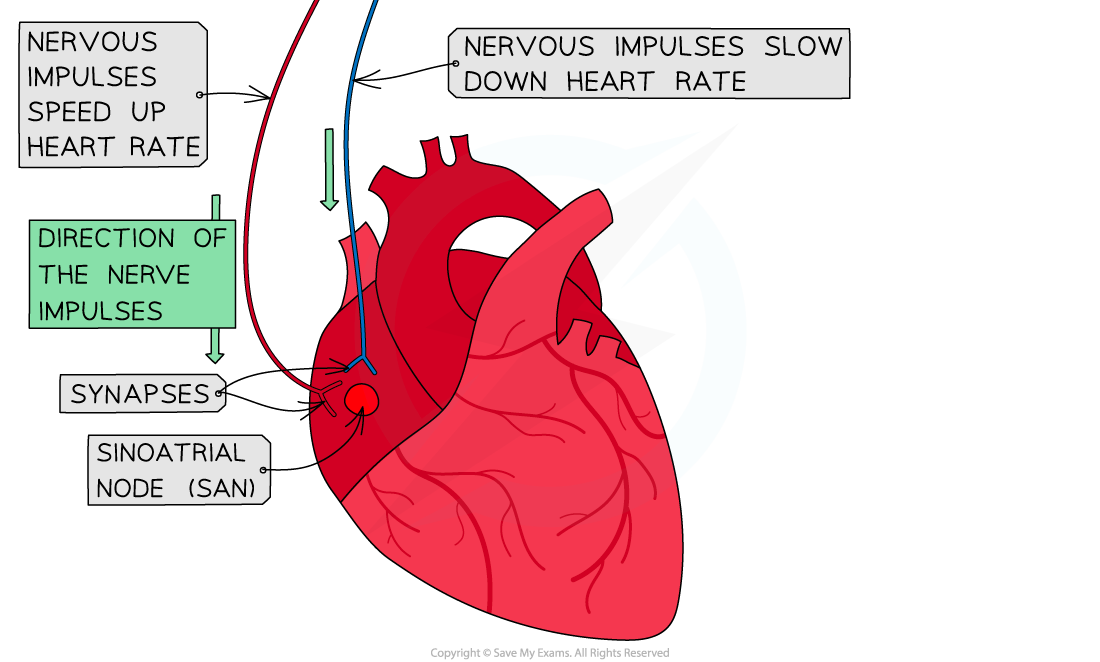Control Mechanisms (DP IB Biology): Revision Note
Control of the Endocrine System
A hormone is a chemical messenger produced by an endocrine gland and carried by the blood
They are chemicals which transmit information from one part of the organism to another and bring about a change
They alter the activity of one or more specific target organs
Hormones are used to control functions that do not need instant responses
The endocrine glands that produce hormones in animals are known collectively as the endocrine system
A gland is a group of cells that produces and releases one or more substances (a process known as secretion)
Control of the endocrine system is primarily by the hypothalamus and the pituitary gland
The hypothalamus
The hypothalamus monitors the blood as it flows through the brain and, in response, releases hormones or stimulates the neighbouring pituitary gland to release hormones
The hypothalamus plays an important role in some homeostatic mechanisms
Hypothalamus functions include
Regulating body temperature
The hypothalamus monitors blood temperature and initiates a homeostatic response if this temperature gets too high or too low
Osmoregulation
Cells in the hypothalamus monitor the water balance of the blood and releases the hormone ADH if the blood becomes too concentrated
ADH increases absorption of water in the kidneys
Regulating digestive activity
The hypothalamus regulates the hormones that control appetite as well as the secretion of digestive enzymes
Controlling endocrine functions
The hypothalamus causes the pituitary gland to release hormones that control a variety of processes e.g. metabolism, growth and development, puberty, sexual functions, sleep, and mood
The pituitary gland
The pituitary gland is located below the hypothalamus
Its role is to produce a range of hormones
Some of these directly influence and regulate processes in the body while some stimulate the release of further hormones from other endocrine glands
The pituitary gland is divided into two sections; the anterior pituitary and posterior pituitary
The anterior pituitary produces and releases hormones
The posterior pituitary stores and releases hormones produced by the hypothalamus e.g. ADH and oxytocin
Feedback Control of Heart Rate
There are several circumstances that can cause an individual's heart rate to increase, such as during exercise
The brain is involved in this response of the heart however it does not require any thinking and is under unconscious control
There is a specific region of the brain that plays a vital role in controlling the heart rate
This cardioregulatory centre in the brain is called the medulla
The medulla is found at the base of the brain near the top of the spinal cord
The medulla is made up of two distinct parts:
The acceleratory centre, which causes the heart to speed up
The inhibitory centre, which causes the heart to slow down
Both centres are connected to the sinoatrial node (SAN) by nerves
These specific nerves are different from the nerves that control conscious activities. They make up the autonomic nervous system
The autonomic nervous system is self-controlling
Control of heart rate diagram


The location of the medulla helps to keep it protected from harm. It has an essential function as a cardioregulatory centre.
Increasing heart rate
Once the acceleratory centre has been activated impulses are sent along the sympathetic neurones to the SAN
Norepinephrine is secreted at the synapse with the SAN
Noradrenaline causes the SAN to increase the frequency of the electrical waves that it produces
This results in an increased heart rate
Decreasing heart rate
Once the inhibitory centre has been activated impulses are sent along the parasympathetic neurones to the SAN
Acetylcholine is secreted at the synapse with the SAN
This neurotransmitter causes the SAN to reduce the frequency of the electrical waves that it produces
This reduces the elevated heart rate towards the resting rate
Chemoreceptors and baroreceptors
Exercise causes several internal conditions to change, creating internal stimuli:
Carbon dioxide concentration in the blood increases
There is an initial fall in blood pressure caused by the dilation of muscle arterioles
These internal stimuli can be detected by chemoreceptors and baroreceptors (pressure) receptors located in the aorta (close to the heart) and in the carotid arteries (they supply the head with oxygenated blood)
Chemoreceptors detect changes in blood pH and oxygen and carbon dioxide levels
Baroreceptors monitor changes in blood pressure
Location of the baroreceptors and chemoreceptors

Baroreceptors are located on the arch of the aorta and on the enlargement of the carotid arteries called the sinus. Chemoreceptors are located near the baroreceptors but on the outside of the aorta and carotid arteries
These receptors release nerve impulses that are sent to the acceleratory and inhibitory centres (coordinators)
The frequency of the nerve impulses increases or decreases depending on how stimulated the receptors are:
Lower frequency impulses activate the inhibitory centre to slow down the heart rate and stroke volume
Higher frequency impulses activate the acceleratory centre to speed up the heart rate and stroke volume

The processes involved in the control of the heart rate. The internal stimuli are detected by chemoreceptors and baroreceptors that send impulses to coordinators (accelerator centre or inhibitory centre). The coordinators send signals to the effector (SAN) which produces a specific response.
Feedback Control of Ventilation Rate
Ventilation rates in the body are controlled by cells called respiratory centres which are located in the medulla of the brain
At rest, action potentials, produced at random, travel to the diaphragm and intercostal muscles to initiate contraction and therefore ventilation; this occurs at a stable and slow pace
During exercise, higher levels of carbon dioxide are produced due to an increase in respiration
Waste carbon dioxide produced during respiration diffuses from the tissues into the blood
This waste carbon dioxide is transported around the body in different ways
In the blood plasma in the form of hydrogen carbonate ions (HCO3-); around 85 % of carbon dioxide is transported in this way
Around 5 % of carbon dioxide dissolves directly in the blood plasma
Bound to haemoglobin as carbaminohaemoglobin; this accounts for around 10 % of carbon dioxide transport in the blood
pH changes in the blood
Carbon dioxide released as a waste product from respiring cells diffuses into the cytoplasm of red blood cells
Inside red blood cells, carbon dioxide combines with water to form carbonic acid (H2CO3)
CO2 + H2O ⇌ H2CO3
Red blood cells contain the enzyme carbonic anhydrase which catalyses the reaction between carbon dioxide and water
Without carbonic anhydrase, this reaction proceeds very slowly
The plasma contains very little carbonic anhydrase hence H2CO3 forms more slowly in plasma than in the cytoplasm of red blood cells
Carbonic acid dissociates readily into hydrogen ions (H+) and hydrogen carbonate ions (HCO3-)
H2CO3 ⇌ HCO3– + H+
Hydrogen ions can lower the pH of the blood so their presence is detected by chemoreceptors in the medulla
Action potentials are sent at a higher rate to the diaphragm and intercostal muscles of the lungs to increase ventilation rates and the volume of air being moved into and out of the lungs
The pH of the blood can then return to normal and respiratory centres will stop sending action potentials to the diaphragm and the intercostal muscles, ventilation rates will return to normal resting rates
This is an example of negative feedback
Control of Peristalsis in Digestive System
Peristalsis is series of muscle contractions in the walls of the oesophagus or small intestine that pass like a wave along the alimentary canal
This wave forces the bolusof food along the alimentary canal
These contractions are controlled unconsciously by the autonomic nervous system, specifically the enteric nervous system (ENS)
The ENS consists a web of sensory neurones, relay neurones and motor neurones embedded in the tissues of the alimentary canal
Peristalsis is controlled by circular and longitudinal muscles which initiate a mechanism called the peristaltic reflex
These muscles are smooth muscle (not striated)
The bolus of food is detected by stretch receptors (sensory neurones of the ENS) as the alimentary canal becomes distended
An action potential is passed to relay neurones of the ENS which synapse with two different motor neurones
One motor neurone releases an excitatory neurotransmitter which stimulates
Longitudinal muscles to contract behind the bolus to reduce the length of that section the oesophagus or the small intestine
This forces the food forwards through the alimentary canal
Circular muscles contract to reduce the diameter of the lumen of the oesophagus or small intestine
This prevents the food moving backwards towards the mouth
A second motor neurone releases an inhibitory neurotransmitter which stimulates smooth muscle ahead of the bolus to relax and open the lumen of the alimentary canal
Control of peristalsis diagram

The control of peristalsis is initiated by the bolus and is carried out by two different motor neurones

You've read 0 of your 5 free revision notes this week
Unlock more, it's free!
Did this page help you?
